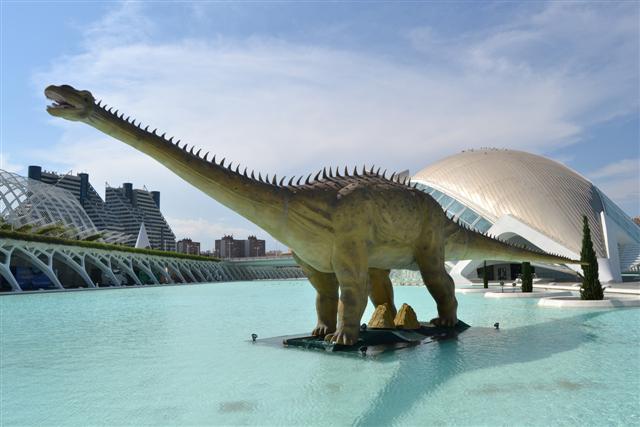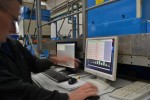Valencia City of Arts and Sciences

PANORAMA OF CITY OF ARTS AND SCIENCES VALENCIA
I defy anyone who comes to Valencia city not to be entranced by the City of Arts and Sciences. It is, justifiably, one of the greatest tourist attractions in Spain and a tribute to modern Spanish vision and design. Indeed, the City of Arts and Sciences is such a triumph that, alone, it makes any visit to Spain worthwhile.
However, the City of Arts and Sciences in Valencia city is avowedly not just for intellectuals or students of architecture. The crowning glory of the whole complex is that it is functional and (in stark contrast to the UK government’s concept for the Dome) its many facets will remain useable for the whole family – for generations to come. This is because the buildings of the Valencia City of Arts and Sciences have been designed to last – and to provide a broad cross-section of activities.
So, the great thing for you as a visitor is that you can come here alone – or with your whole family, however young. You can simply walk around the Arts and Sciences complex and marvel at the architecture or you can take your family into the Oceanographic to wonder at the largest aquarium in Europe. Or you can all go to the Science museum and revel in three floors of interactive science and technology. Or you can see exhibitions in the Agora – or attend an opera or other performing arts in the Queen Sofia Palace of Arts. Or you can go to the Hemispheric and thrill to an Imax cinema and the planetarium and laserium. Or you can just relax along the glorious walkway of L’Umbracle amidst Valencia’s native plants and modern sculptures.
Or, or or…

El Palau de les Arts Reina Sofía Valencia - the Arts Museum Valencia
In fact, there is so much to see and do at the Valencia City of Arts and Sciences that a single day will barely scratch the surface of what is on offer. Meanwhile, a night visit is imperative as you will then be able to thrill to the beautifully lit vision of the whole complex. Simply fabulous!
The Valencia City of Arts and Sciences (La Ciudad de las Artes y de las Ciencias de Valencia) was designed, of course, by Santaigo Calatrava and Félix Candela – although the latter died in 1997 and never saw the completion of the project. Both men are renowned for their modernist architecture in which they combine avant gard designs with extraordinary structural engineering. This, to my mind, is what makes their designs so unusual and daring.
Santiago Calatrava (Valencian born 1951) is particularly interesting as he is both a qualified architect and structural engineer, together with being a renowned painter and sculptor. To him architecture is all the arts in one and this is something that comes across when you see the City of Arts and Sciences – which seem to blend all of his talents (part sculpture, part mind- boggling engineering, part architecture and part, well, modernist painting!).

Valencia City and the wonderful City of Arts and Sciences - The Hemispheric
The scale of the City of Arts and Science in Valencia is also impressive. The complex is just under 2 kms long and based in the river bed of the Turia, which was diverted after ravaging Valencia during floods in 1957. The distinct parts of the complex are:
1. The Hemospheric (L’Hemisfèric) — an Imax cinema, planetarium and laserium, in the shape of an eye. It is some 13,000 and has a 900m2 concave screen, large-format cinema, IMAX Dome and a 12×6 m2 Digital 3D screen.
2. The Science Museum (El Museu de les Ciences Piíncipe Felipe) – 40,000 m2 of interactive science and technology on three floors – which is fantastic for children!

SCIENCE MUSEUM VALENCIA
3. The Oceanographic (L’Oceanogràfic) – 110,000 square meters, 42 million litres of water, over 500 marine species (and 45,000 creatures) making it the largest aquarium in Europe and all built in the shape of a water lily. It has nine different themes: Mediterranean, Wetlands, Temperate, Tropical Seas, Oceans, Antarctic, Arctic, Islands and the Red Sea, together with a dolphinarium. There is also a spectacular tunnel through which you can walk surrounded by fish!
4. The Queen Sofia Palace of Arts (El Palau de less Arts Reina Sofia) – a centre for the performing arts and opera.
5. L’Agora — a covered plaza for concerts, performances and sporting events.

Agora Valencia
6. L’Umbracle — a 17,500 m2 landscaped walk with sculptures from contemporary artists. Below is the main car park for the City of Arts and Sciences complex.
7. El Puente de l’Assut de l’Or – a terrific bridge with a magnificent sail structure.
8. The landscaped areas surrounding the main buildings. This has been beautifully landscaped with aquatic areas which mirror the main buildings and provide plenty of space for picnics and relaxation. The grounds clearly succeed in achieving Calatrava’s aim because he stated: ‘“As the site is close to the sea, and Valencia is so dry, I decided to make water a major element for the whole site using it as a mirror for the architecture.” How wonderful to see his vision work so well!

Dinosaurs in Valencia!
Wow! Can you really resist visiting Valencia city to see the City of Arts and Sciences?
Surely not?
Incidentally, the City of Arts and Sciences is very well signposted throughout Valencia city (in case you are driving) and is within the city itself, in case you thought it was on the outskirts. There is a metro station within walking distance to the City of Arts and Sciences and buses regularly stop there. So, access to the complex is easy with parking normally not too much of a problem. Meanwhile, for those of you who want to go shopping there is a large shopping complex within a few minutes walk of the area.
If you go – do tell me what you think!
RELEVANT INFORMATION
Official www. of the Valencia City of Arts and Sciences
All photos courtesy of Alex Snelling
Original Page: http://www.culturespain.com/holiday-spain/valencia-city-of-arts-and-sciences
Sent from Feeddler RSS Reader










































